Motorcycle Cruise Control makes a terrific motorcycle-specific aftermarket option for a lot of different makes and models of motorcycles.
Their customer service and manufacturing quality exceed my expectations substantially.
I keep thinking “What can I add to the motorcycle that will make the riding experience better?”
It seems like I’ve been doing a lot of that lately.
There are two major things that make a long ride less enjoyable:
1.) An uncomfortable saddle and 2.) A wrist cramp.
This article focuses on the latter. I’ve played around over the years with a few different throttle locks and grip modifications to help hold the speed on my bike.
These work, after a fashion, but they’re not as effective as a real cruise control.
There are lots of manufacturers of touring-class motorcycles that offer cruise control. Sadly, my model Honda isn’t one of them.
In the interest of science, and perhaps due to my own desire to travel as comfortably as possible, I made the decision to research options for adding an electronic cruise control.
I found a few articles on adapting an automotive-specific Audiovox CCS-100 to my motorcycle — I even spent the meager amount on the parts and gave it a whirl.
Sadly, it produced mixed results. I read plenty of places where folks were able to get the cruise control working on their motorcycle; but I just decided that kludging something together wasn’t an option I really wanted to go with.
I’d rather not be in the middle of nowhere when the cruise control decides to give up the ghost, leaving me with few options.
After a little more research, I located Motorcycle Cruise Control in Australia. Yep — the land Down Under.
I know it was a stretch, but their website included detailed articles on their cruise controls and more importantly, their units were made exclusively for motorcycles.
As I was getting ready to leave for a 2,700 mile journey in a week, I decided to give their unit a try.
I want to start this section with a disclaimer: the folks at Motorcycle Cruise Control are fantastic. They provided nothing but prompt, friendly customer service. I can’t say enough about them.
But any time someone starts a paragraph like that, you probably know what’s coming next. Indeed.
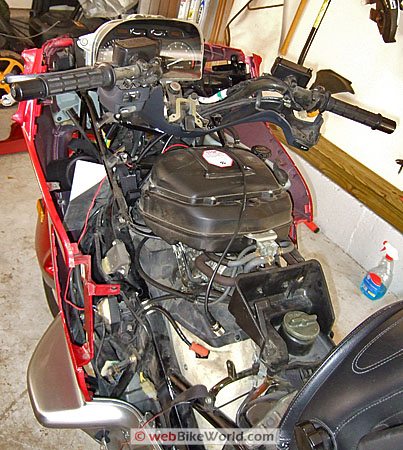
Where to Buy Motorcycle Cruise Control Accessory
Check Reviews & Prices on AmazonSee More: Motorcycle Accessories, Motorcycle Tire, Motorcycle Helmets
Choosing a Motorcycle Cruise Control
I chose the unit I wanted for my bike and went through the steps to make the online purchase. Now it says the retail for my unit is $628.00, but that’s Aussie dollars.
Since the exchange rate shifts each day, there’s no way to price this consistently in Greenbacks. In this case, the US cost translated to around $543.00.
I entered my VISA Check Card information into the system and promptly got declined. I thought I must’ve entered the digits wrong on the card, because there was nearly $7,500.00 available in that account.
So I entered the information again and — yep, got declined once more.
Frustrated, I decided to call Australia. I’m sure this wasn’t an inexpensive call — I haven’t gotten the bill yet, but I bet it’ll be a surprise when it comes.
At 9:00pm U.S. Mountain Time, it’s something like 2:00 pm the next day in Australia, and Tony Guymer from Motorcycle Cruise Control was happy to take my call.
I explained what was going on, and he said “‘right mate. Sometimes folks from the states have this happen as part of fraud protection on their card. There’s nothing we can do from our end. You’ll need to contact your card issuer.”
So I did — U.S. Bank. When I say they were less than helpful, it’s an understatement.
Apparently, to protect cardholders (you can read that as U.S. Bank protecting themselves and passing it off as protecting the cardholder) they subscribe to a service called “Falcon” that determines whether or not your purchase is legitimate.
U.S. Bank has no control over the decisions that “Falcon” makes and their decision is, apparently, final.
Oh, and by the way — there’s no way for the consumer to contact them to tell them this is a legitimate purchase.
So, let’s see: If I want to use my VISA card to purchase something, a third party screener will determine whether or not I can spend my money? Sounds a little “Big Brother” to me my friends.
So I had to pull out my Bank of America VISA card and give that a try. This time, instead of doing it over the Internet, I called Tony back personally and read the card numbers to him.
Guess what?
The authorization went through immediately. Apparent Bank of America doesn’t use this helpful service, so there’s a consumer safety tip for you.
Anyway, Motorcycle Cruise Control told me they’d get everything packaged up and shipped out via priority worldwide shipping so I can have the unit in time for an install, a checkout and the big ride.
Thank you, Motorcycle Cruise Control! True to their word, the package from Australia arrived on my doorstep in Colorado three days later; inside is the kit, cables, instructions and a roll crimper I purchased from them.
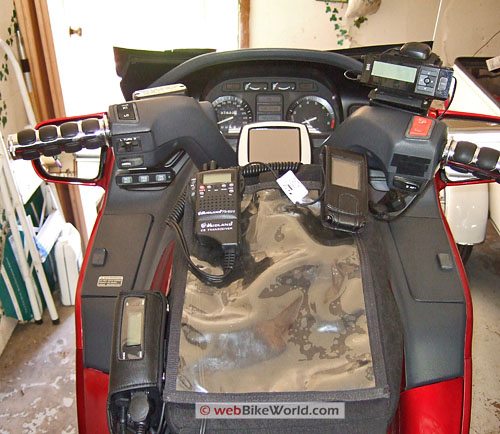
Motorcycle Cruise Control Installation
Let me say this clearly: this is not a project for the faint of heart!
Installing an electronic cruise control requires reading and then re-reading the instructions before you turn a screwdriver.
Although some models of the Motorcycle Cruise Control units come with customized wiring looms, mine wasn’t one of those models, unfortunately.
This meant that I was not only going to install a cruise control, but that I would be customizing it to fit my motorcycle.
To be able to access the areas that I needed on the bike, such as the vacuum takeoff on the carburetors, I had to virtually disassemble the entire bike.
Thankfully, taking this step made everything else go much easier, although it added significantly to the time on the overall project.
The instructions are excellent — well thought out, well laid out and with photos that help you visualize what is required at each step along the way.
I fortunately discovered a convenient place in the trunk of a saddlebag to mount the “brain” of the cruise control, and I followed Motorcycle Cruise Control’s directions on how to lay everything else out to fit.
They even tell you which end of the cables to trim and how to crimp the connections and get everything reconnected. It’s crucial that you take your time and follow the instructions step-by-step.
If you do, the final product will be installed in a manner that looks as if it could have been installed by the manufacturer.
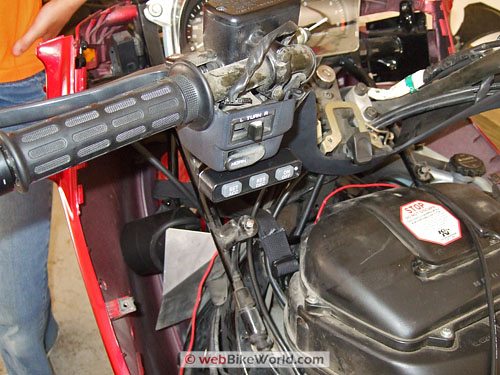
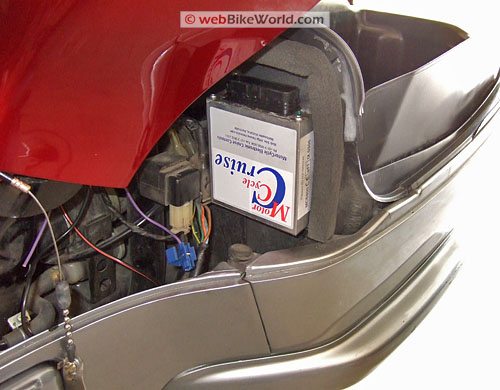
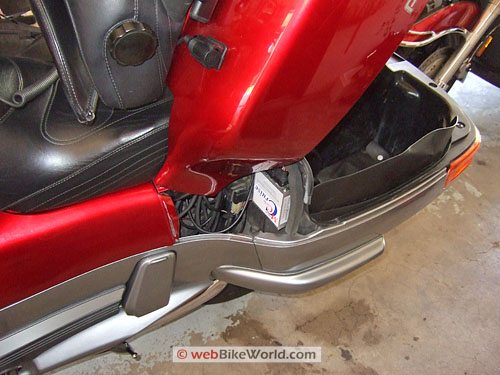
Where to Buy Motorcycle Cruise Control Accessory
Check Reviews & Prices on AmazonSee More: Motorcycle Accessories, Motorcycle Tire, Motorcycle Helmets
Cruise Control Calibration
I re-assembled the bike and began reading the sections on calibrating the cruise control for my ride.
Again, it is important to read the instructions carefully and perhaps even take them with you on the test and tune portion of the ride.
For the record: this is a time consuming process as well. You must perform the calibrations step-by-step as described, and minor adjustments to certain settings may require you to start over at the beginning.
After running through the speed sensor, throttle pull and various other tests it was time to make a ride and see how it performs. For whatever it’s worth, I had nearly seven hours of labor installing the unit at this point.
Most of that is the disassembly and reassembly time for the fairings and such on my bike, but the cruise and wiring loom does take a fair amount of time for proper fitment.
I went on a quick jaunt around the area on varied road conditions.
There were some slight hills but no monsters. The cruise control performed extremely well on the initial ride — it held the speed within 3-4 MPH even on the hills, which is better than some cars I’ve seen.
I was all ready to take the big ride a see how this thing performs on the long haul.
Remember how I’ve emphasized, if not over-emphasized, reading the directions very carefully? That’s because I didn’t.
During the initial speed sensor calibration, I set it while going up a slight hill at 45 MPH.
Turns out, this gives you a “softer” throttle pull when you engage the cruise. I found that at 75MPH and going up a hill the cruise control would lag significantly.
This is important, because there’s a built-in safety feature that forces the cruise to automatically shut off if the speed drops below 80% of the set speed.
What this means is that if you are going up a steep hill on cruise at 75 MPH and the cruise engages late and soft, it’s possible for your speed to drop below 60 MPH at which time the cruise automatically turns off. See the issue?
After re-reading the instructions, I re-calibrated the system in Idaho Falls, Idaho and tried again. This time, voila! Everything works like a charm. I can hold a consistent and steady speed no matter what the terrain.
The cruise works very much like an automotive cruise with on/off, set/accelerate and resume/decelerate functions on three buttons that are also illuminated.
There’s also an LED on the far right that provides visual feedback on cruise control operation and status.
I rode this unit from Idaho Falls through Yellowstone National Park to Billings, Montana to Rapid City, South Dakota and not only did it keep a consistent speed, I found that my gas consumption improved as well.
Prior to using the Motorcycle Cruise Control manufactured cruise, I would average 42.5 MPG on the highway. When using the cruise, I averaged 46 MPG.
That may not seem like much, but when you consider a savings of 3.5 MPG and gas costs at or above $3.00 per gallon, you can quickly add up the savings on a long ride.
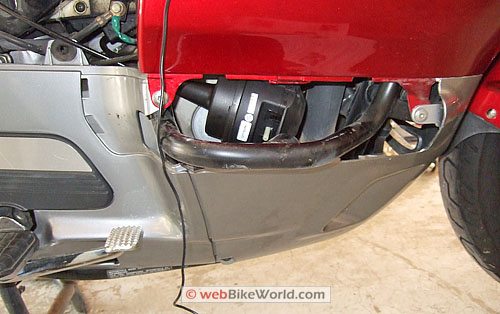

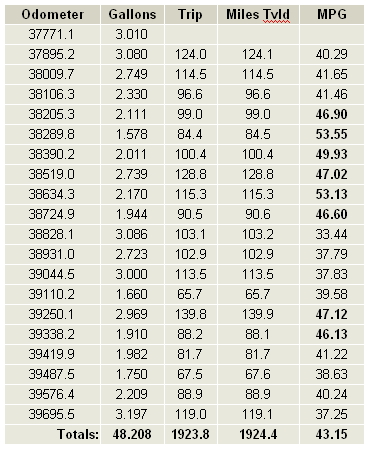
Conclusion
So here’s my conclusion: Motorcycle Cruise Control makes a terrific motorcycle-specific aftermarket option for a lot of different makes and models of motorcycles.
Their customer service and manufacturing quality exceed my expectations substantially.
The unit mated perfectly with my ride and the performance is fantastic — as long as you take time to follow the directions step-by-step.
The unit may need to be recalibrated a couple of times for best performance, but in the end it will be a much better working product that adds, rather than detracts, to the enjoyment of riding.
The bottom line is that you can have less rider fatigue and it just might even save you some money in the long run.
| wBW Review: Motorcycle Cruise Control | |
|---|---|
| Manufacturer: Motorcycle Cruise Control | List Price (August 2007): Varies by make and model, approx. $550.00 USD |
| Colors: N/A | Made In: Australia |
| Comments: Units available for many makes and models, including BMW, Ducati, Harley Davidson, Honda, Kawasaki, Suzuki, Triumph, Yamaha. “Universal” kits also available. | |
| Review Date: August 2007 | |
Where to Buy Motorcycle Cruise Control Accessory
Check Reviews & Prices on AmazonSee More: Motorcycle Accessories, Motorcycle Tire, Motorcycle Helmets
Owner Comments and Feedback
See details on submitting comments.
From “K.K.”: “Glad to see you reviewed the MCCruise control. I bought one last year and installed it on my FJR1300 with the help of a friend more knowledgeable about motorcycle electrical systems.
Yes it took awhile, but it was well worth it.
The documentation could have been better organized, but was very thorough. technical support from the company was excellent.
By the way, if your reviewer had done a bit more research (such as Googling MCCruise) he would have found that there is an internet vendor in the U.S. selling these products. I bought from them.
They also provided good support and I got the product quickly.”
Shawn’s Reply: The U.S. distributor merely orders the stuff from the Aussies once the order is placed. They don’t keep a Honda Pacific Coast cruise in stock!
Anyway, since I wanted in an expedited fashion, I ordered it direct from the manufacturer rather than using a distributor.
So, it wasn’t that I wasn’t aware of US distributors; it was that I wanted it faster and adding in a “middle man” for the order would have slowed things down for me.
From “G.K.”: “Thanks so much for your motorcycle cruise control review. Unfortunately I just got finished rebuilding the engine on my Harley, but as soon as I can justify the $500 I will be purchasing/installing one of these.
I noticed you didn’t mention safety at all. Do you feel using cruise control on your bike makes it any more or less safe?
Shawn’s Reply: If anything, it’s made my ride more safe. I say this because I find I’m not as fatigued thanks to the throttle control on the long rides.
The safeties on the system disengage the cruise anytime you activate either brake or if you pull in the clutch. It’s very quick to disengage and I’ve never felt like I wasn’t 100% in control of the bike at all times.”
From “D.C.”: “I have the unit on a 2006 Suzuki Burgman Executive 650. This is one of the models with an available wiring harness. It was already installed when I bought the scooter so I can’t attest to the ease / difficulty of installation.
I will say that the installation instructions are good enough that even a klutz like me could complete the process successfully.
I can categorically state that the system works flawlessly and it has really enhanced the riding experience on long rides; especially in freeway riding.
It may be an expensive proposition but it’s a high quality product that’s well engineered and does what you expect of it. If you change bikes every season, it may not be cost effective but if you keep your ride for several years the benefits far outweigh the cost.”

